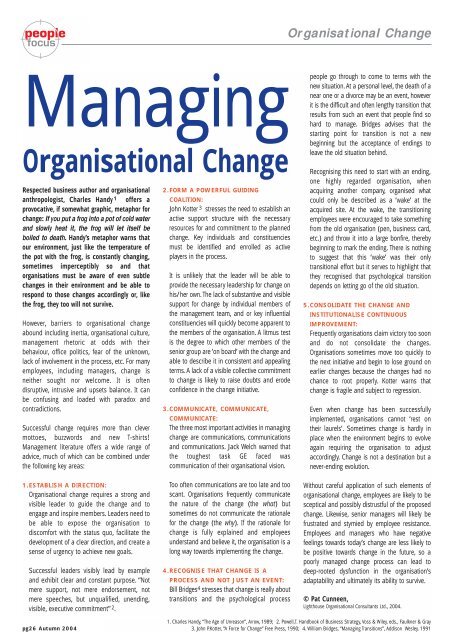People Focus Spring 04 NA - CIPD
People Focus Spring 04 NA - CIPD
People Focus Spring 04 NA - CIPD
- No tags were found...
You also want an ePaper? Increase the reach of your titles
YUMPU automatically turns print PDFs into web optimized ePapers that Google loves.
Organisational ChangeManagingOrganisational ChangeRespected business author and organisationalanthropologist, Charles Handy 1 offers aprovocative, if somewhat graphic, metaphor forchange: If you put a frog into a pot of cold waterand slowly heat it, the frog will let itself beboiled to death. Handy’s metaphor warns thatour environment, just like the temperature ofthe pot with the frog, is constantly changing,sometimes imperceptibly so and thatorganisations must be aware of even subtlechanges in their environment and be able torespond to those changes accordingly or, likethe frog, they too will not survive.However, barriers to organisational changeabound including inertia, organisational culture,management rhetoric at odds with theirbehaviour, office politics, fear of the unknown,lack of involvement in the process, etc. For manyemployees, including managers, change isneither sought nor welcome. It is oftendisruptive, intrusive and upsets balance. It canbe confusing and loaded with paradox andcontradictions.Successful change requires more than clevermottoes, buzzwords and new T-shirts!Management literature offers a wide range ofadvice, much of which can be combined underthe following key areas:2.FORM A POWERFUL GUIDINGCOALITION:John Kotter 3 stresses the need to establish anactive support structure with the necessaryresources for and commitment to the plannedchange. Key individuals and constituenciesmust be identified and enrolled as activeplayers in the process.It is unlikely that the leader will be able toprovide the necessary leadership for change onhis/her own.The lack of substantive and visiblesupport for change by individual members ofthe management team, and or key influentialconstituencies will quickly become apparent tothe members of the organisation. A litmus testis the degree to which other members of thesenior group are ‘on board’ with the change andable to describe it in consistent and appealingterms.A lack of a visible collective commitmentto change is likely to raise doubts and erodeconfidence in the change initiative.3.COMMUNICATE, COMMUNICATE,COMMUNICATE:The three most important activities in managingchange are communications, communicationsand communications. Jack Welch warned thatthe toughest task GE faced wascommunication of their organisational vision.people go through to come to terms with thenew situation.At a personal level, the death of anear one or a divorce may be an event, howeverit is the difficult and often lengthy transition thatresults from such an event that people find sohard to manage. Bridges advises that thestarting point for transition is not a newbeginning but the acceptance of endings toleave the old situation behind.Recognising this need to start with an ending,one highly regarded organisation, whenacquiring another company, organised whatcould only be described as a ‘wake’ at theacquired site. At the wake, the transitioningemployees were encouraged to take somethingfrom the old organisation (pen, business card,etc.) and throw it into a large bonfire, therebybeginning to mark the ending. There is nothingto suggest that this ‘wake’ was their onlytransitional effort but it serves to highlight thatthey recognised that psychological transitiondepends on letting go of the old situation.5.CONSOLIDATE THE CHANGE ANDINSTITUTIO<strong>NA</strong>LISE CONTINUOUSIMPROVEMENT:Frequently organisations claim victory too soonand do not consolidate the changes.Organisations sometimes move too quickly tothe next initiative and begin to lose ground onearlier changes because the changes had nochance to root properly. Kotter warns thatchange is fragile and subject to regression.Even when change has been successfullyimplemented, organisations cannot ‘rest ontheir laurels’. Sometimes change is hardly inplace when the environment begins to evolveagain requiring the organisation to adjustaccordingly. Change is not a destination but anever-ending evolution.1.ESTABLISH A DIRECTION:Organisational change requires a strong andvisible leader to guide the change and toengage and inspire members. Leaders need tobe able to expose the organisation todiscomfort with the status quo, facilitate thedevelopment of a clear direction, and create asense of urgency to achieve new goals.Successful leaders visibly lead by exampleand exhibit clear and constant purpose. “Notmere support, not mere endorsement, notmere speeches, but unqualified, unending,visible, executive commitment” 2 .Too often communications are too late and tooscant. Organisations frequently communicatethe nature of the change (the what) butsometimes do not communicate the rationalefor the change (the why). If the rationale forchange is fully explained and employeesunderstand and believe it, the organisation is along way towards implementing the change.4.RECOGNISE THAT CHANGE IS APROCESS AND NOT JUST AN EVENT:Bill Bridges 4 stresses that change is really abouttransitions and the psychological processWithout careful application of such elements oforganisational change, employees are likely to besceptical and possibly distrustful of the proposedchange. Likewise, senior managers will likely befrustrated and stymied by employee resistance.Employees and managers who have negativefeelings towards today’s change are less likely tobe positive towards change in the future, so apoorly managed change process can lead todeep-rooted dysfunction in the organisation’sadaptability and ultimately its ability to survive.© Pat Cunneen,Lighthouse Organisational Consultants Ltd., 20<strong>04</strong>.pg26 Autumn 20<strong>04</strong>1. Charles Handy, “The Age of Unreason”, Arrow, 1989; 2. Powell,T. Handbook of Business Strategy, Voss & Wiley, eds., Faulkner & Gray3. John P.Kotter, “A Force for Change” Free Press, 1990; 4. William Bridges, “Managing Transitions”, Addison Wesley, 1991
















